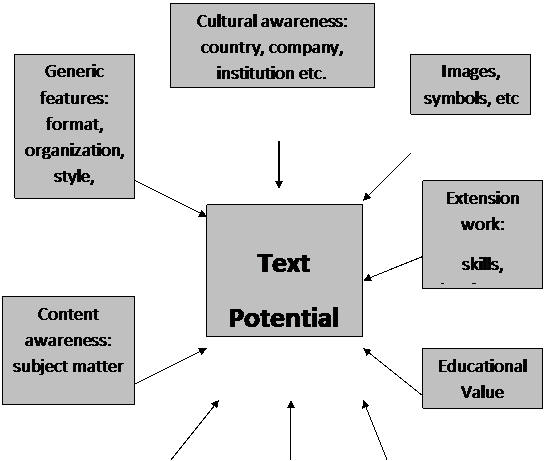Study the scheme. Make some notes to use the information for scientific reading.
Text Potential
 |
|
|
| ||||||
ПРИМЕЧАНИЕ № 1
Academic Reading
Read the information below and try to use it working with different kinds of text
While working with the certain text you can use different methods to understand the text better and to summarize the information for presentation or reference in your scientific research:
Skimmingis used to quickly identify the main ideas of a text. When you read the newspaper, you're probably not reading it word-by-word. Skimming is done at a speed three to four times faster than normal reading. People often skim when they have lots of material to read in a limited amount of time. Use skimming when you want to see if an article may be of interest in your research.
There are many strategies that can be used when skimming. Some people read the first and last paragraphs using headings, summarizes and other organizers as they move down the page or screen. You might read the title, subtitles, subheading, and illustrations. Consider reading the first sentence of each paragraph. Skimming might be used to review graphs, tables, and charts.
Scanningis a technique you often use when looking up a word in the telephone book or dictionary. You search for key words or ideas. In most cases, you know what you're looking for, so you're concentrating on finding a particular answer. Scanning involves moving your eyes quickly down the page seeking specific words and phrases. Scanning is also used when you first find a resource to determine whether it will answer your questions. Once you've scanned the document, you might go back and skim it.
When scanning, look for the author's use of organizers such as numbers, letters, steps, or the words, first, second, or next. Look for words that are bold faced, italics, or in a different font size, style, or color. Sometimes the author will put key ideas in the margin.
A summary, synopsis, or recap is a shorter version of the original. Such a simplification highlights the major points from the much longer subject, such as a text, speech, film, or event. The purpose is to help the audience get the gist in a short period of time.
A written summary starts with a lead, including title, author, text type, and the main idea of the text. It has a clearly arranged structure and is written in a logical, chronological, and traceable manner. In contrast to a résumé or a review, a summary contains neither interpretation nor rating. Only the opinion of the original writer is reflected – paraphrased with new words without quotations from the text. Unlike a retelling, a summary has no dramatic structure and is written in present tense or historic present. In summaries only indirect speech is used and depictions are avoided. Summaries of books or dissertations present the major facts in common scientific language.
Summary in nonfiction. Nonfiction summaries serve to familiarize the reader with the subject matter of an entire work in a short space of time. They are written in a balanced and objective way, mirroring the genre’s aim to portray actual events from the author’s point of view. Generally, nonfiction summaries do not offer analysis or assessment.
Summarizers use their own words to write the shortened versions and draw on the original make-up of the pieces to structure the distillations. They exclude superfluous examples, descriptions and digressions. The opening sentence should introduce the topic, and the final sentence should sum up the theme, taking into account the knowledge gained from the body of the text. In recent years, a summarizing industry has sprung up. Shorter, more concise nonfiction summaries are called abstracts. They are approximately five pages, thus longer than scientific abstracts.
7. Рекомендации следовательской работе обучающихся:
- Примерные темы проектов / докладов: Academic Reading
8. Рекомендуемая литература по теме занятия:
- основная
| № п/п | Наименование, вид издания | Автор (-ы), составитель (-и), редактор (-ы) | Место издания, издательство, год | Кол-во экземпляров | |
| в библио-теке | на кафедре | ||||
| 1. | Английский язык для менеджеров : учеб. пособие | Агабекян И.П. | Ростов н/Д.: Феникс, 2010 | - | |
| | Бизнес- английский | С.А.Шевелева | Кнорус, | - |
- дополнительная
| № п/п | Наименование, вид издания | Автор (-ы), составитель (-и), редактор (-ы) | Место издания, издательство, год | Кол-во экземпляров | |
| в библио-теке | на кафедре | ||||
| 1. | Новый англо-русский медицинский словарь | Ред. В.А. Ривкин [и др.] | М.: ABBY Press, | ||
| 2. | Новый англо-русский, русско-английский медицинский словарь. | Мокина Н. Р. | М.: ABBY Press, 2010 | ||
| 3. | English 365 [Электронный ресурс] : учебник - 1 электр. опт. диск (CD) | Bob Dignen, Steve Flinders, Simon Sweeney. | Cambridge: Cambridge University Press, 2007. | - | |
| 4. | Деловой английский язык [Электронный ресурс] : учеб. пособие. 1 электр. опт. диск (СD). | М. : Неотехсофт, 2006 | - | ||
| 5. | English, Business and Finance [Электронный ресурс] : учеб. пособие. – 1 электр. опт. диск (CD) | Volkova O.V. | LAP LAMBERT Academic Publishing. – 2012. | - | |
| 6. | Lingvo 12 [Электронный ресурс] : словарь. - 1 электр. опт. диск (CD) | ABBYY Software House | М. : Аби Софтвер, 2008 | - |
Занятие №5
